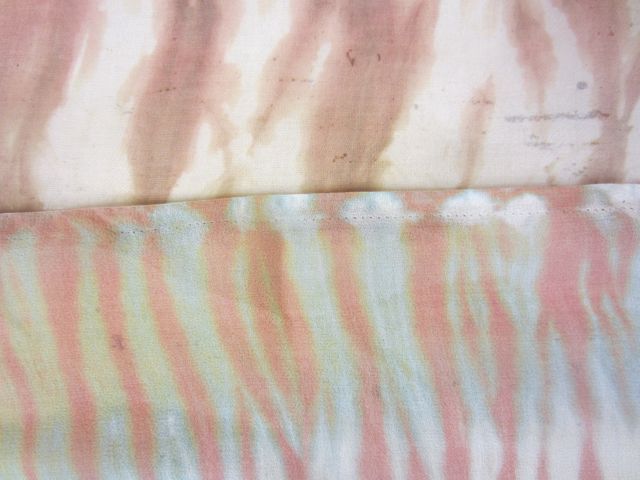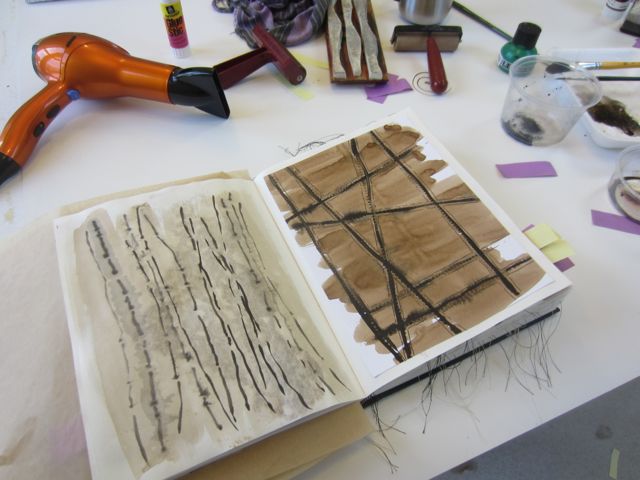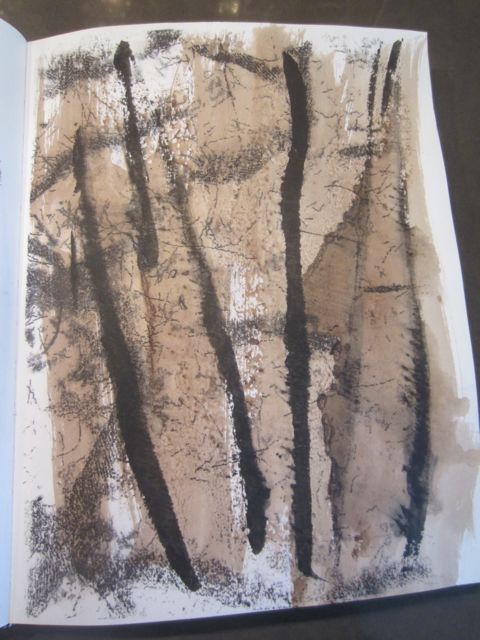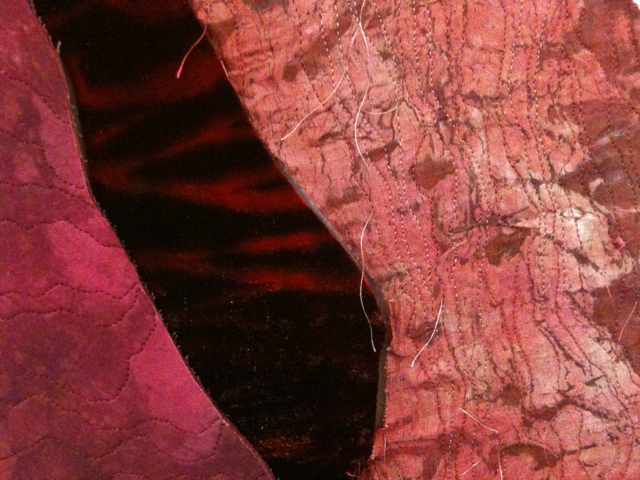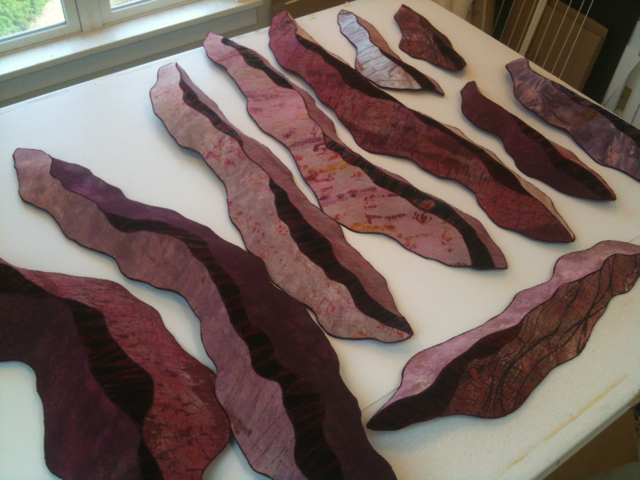I’ve started on the new work for my show in March. I’m drawing, working on samples, and dyeing. The color way I’m using for the dyeing is based on the warms browns, oranges, and greens of Madrone trees. Today I painted with dye in an attempt to capture some of the essence of the marks in the book I made a few weeks ago. Tomorrow I’ll wash it out, see where I am, and dye some more.
Monthly Archives: October 2012
In Print!
Color Tests
This week I’ve been filling in some missing pages in my dye book. Somehow, in all the colors I have used and tested over the years there are no blues! Not really surprising when I look back at my work. About the only time I use blue is when I’m teaching. My intern, Mia, has done a terrific job doing tests on small pieces of fabrics so that I can see the colors hidden in the jars of dry dye.
I’m spending a lot of time these days drawing and cogitating on my solo show coming up in March at Foster/White. I’m planning to do an installation with big panels of dyed organza. I thought I’d do some tests while the dyes were mixed and ready. I sewed the panels into sleeves that fit on to my pvc pipes then smooshed them down rather than wrapping each with cord. It’s a bit of cheat but you can still get really beautiful results. Since I’m looking at doing 50 yards, I need to do it in a way that’s achievable in the time frame.
Wow! What an interesting set of results! I dyed both organza and a silk chiffon and got really different colors and effects. I used New Black 300 from Dharma, Chino from ProChem and Chocolate Brown from Dharma. Black and browns on silk are really hard to get using procion dyes and an alkaline fixative because of the way the dye chemistry works. Reds strike first and can dominate the color before the blues come along to shift it.
The chiffon compressed quite a bit and gave a tight and regular pattern and really dramatic color because of the way the dyes split. The marks on the organza were much more irregular and organic and I got a surprisingly good black. I wonder if this is because the seracin is still in the organza while it is stripped out of most silks. Always more research to do.
Although the color effects on the chiffon are very seductive, I’m still planning on using the organza. I like the transparency, the body, and the organic nature of the marks. I’ll have to file away that chiffon for another time and another project. I’m sure I can dream up something.
Stitch on Paper
For the last few weeks I’ve been working on a book. I started it in my workshop with Larry Calkins and it’s what I focused on during my Orcas Island retreat. It’s a repository of marks. It’s a place to make without engaging my inner critic. It’s a place to play and experiment. I’ve been obsessed with it, working both at the studio and at home after everyone’s fed and the kitchen is cleaned up.
In the book I’ve experimented with a lot of different techniques but with a very limited palette: black, white, and brown. I used sumi and walnut inks, white acrylic paint, black and brown water-based printing ink, toner transfers, black and white thread, charcoal, graphite, and conte crayon. I painted, printed, drew, cut, tore, collaged, and stitched. I worked back and forth through the book, adding layers until each page felt complete.
Over the years, my studio-mates and I have critiqued each others’ work both formally and informally. It’s been pretty informal for the last 18 months or so because of transitions in all of our lives. But now that the Fall is upon us we are back to planning and scheduling our sessions. I went first today with my book.
I was excited to show it to them. The book feels big to me, like a dictionary of my personal language of imagery. But I was also nervous. Would they flip through idly? Say, “hmm, that’s nice.” It is, after all, not a finished piece or something I would show in a gallery, but a record of being in the moment. It is an attempt to reset my brain and my hand after a long slog through production before I jump back into the process of making.
I didn’t need to worry. Paul, Anna, and Pam pored over every page. They asked questions, oohed and aahed, got into my process. They really saw the book as the big step that I feel it is. They made suggestions of ways to build on what I’ve started. Ideas of developing some of my visual ideas into drawings or prints. Ideas that make me nervous because I don’t know how to do that yet. Ideas to push me out of my comfort zone. But isn’t that what I’ve been after?
So what have I learned about myself, my process, and my language of mark making? I’ve learned that, at least for now, stitch is integral to my work. By making the choices I did with my media, from stitching on paper to drawing lines of dots to transferring copies of my dyed fabrics, thread and stitch are what I’m drawn to over and over. Color, form, and texture are all important, but stitch is constant.
So where does this lead? What is next? How do I incorporate this into my existing work? I don’t know. I think I just have to start and it will seep in to the new work. It’s already there.
Retreat to Orcas Island
I spent three days alone on Orcas Island this last week at Doe Bay Resort. It’s a lovely spot that I’ve been to many times, but not since my kids were born. I rented a little cabin all to myself and filled it with food, music, and art supplies. I took hikes, drank tea, listened to music, and played at art. It was a retreat, a chance to get some head space after the busy summer, to make marks on paper without attachment, and to be reinvigorated by nature.
I was drawn to the San Juan Islands for their beauty and specifically for the madrone trees. I’ve been thinking about them as inspiration for my next body of work. Madrones, arbutus menziesii, are spectacular trees. Their rough outer orange bark peels away to reveal a muscular bright green inner bark. They grow on rocky cliffs and outcroppings overhanging the sound, twisted by storms. Their textile-like bark sheds and collects in piles at their bases. It was gratifying and satiating to just sit with them.
On my last day on the island I went to a spot that a local told me about that’s not on the tourist maps. It’s a point of land that juts out into the sound and is sacred land to the Lummi Tribe. Like all the hikes I did in my three days, I was completely alone with nature. I followed the faint trail, breaking spider webs, through the brush until I found groves of madrones. It was a special place, quintessentially northwest. As I turned back to my car and the 12:10 Ferry, I stopped and thanked the spirits of the land. It felt right.
Making Marks
I’m taking a little break from making art before I launch in to the next body of work. I have a show scheduled for March at Foster/White. I’ve been a feeling a little dry with my ideas and tight in my process. I’ve known it was time to rediscover pleasure in my work so I’m taking a few weeks to play.
I’m a big fan of Larry Calkin’s work. He’s a local artist who also teaches at Pratt. I feel there is a similarity in our work, more in our process than in any visual style, and we co-taught a class a few years ago. I like that he isn’t constrained by any particular medium but his work is still distinctively his own. He does encaustic, sculpture, jewelry, and sketchbooks. His work is rustic and I’ve actually seen him throw a piece on the ground and walk on it before picking it up and continuing to work on it. I admire him as a teacher and thought he’d be a good resource in my goal of loosening up. So I took a trip out to his studio in Issaquah this week for a sketchbook day. He teaches a sketchbook workshop but the dates didn’t work with my schedule so I arranged a semi-private lesson for me and my studio-mate, Pam.
It was another one of the beautiful Fall days we’ve been having and there were four of us there set up under the trees working in our sketchbooks. Larry’s two dogs, Lizzie and Archie, and his chickens were wandering around as we worked. I made a lot of marks and some mud, literally. Larry uses many rustic tools and techniques including using native clays as pigments. It reminded me of working in the Solstice Parade workshop as I only had to look around on the ground for some bit to incorporate into my work.
Larry uses a toner copier for doing transfers. I brought some copies I had made of my fabrics and used acetone to transfer them into the sketchbook. Then I used walnut ink, conte crayon, charcoal, and collage over the top of them. I also used some sumi ink. It’s a pleasure just to move the brush across the page. It’s good to make marks freely and not be attached to the outcome. It’s good to just give myself permission.
It’s good preparation because I’m going on an artist mini-retreat to Orcas Island next week. Really looking forward to taking this open feeling up there and seeing what happens.
A Well Deserved Break
In the last four months I’ve made 19 new pieces, 10 of which went together to form one piece that’s now hanging in the Forum at the Bellevue Arts Museum. In the last weeks leading up to my delivery date I was pushing hard to get it all done. I did not find time to post here in the blog but I did keep a countdown of sorts on Facebook. It’s so easy to snap a photo with my phone and post it there. It’s immediate and a nice way to keep my friends in the loop. Here are some of the photos and captions I posted there. The photos were taken with my phone so not as good a quality as usual, but you can get the idea.

Just five more panels to stitch, then the backs, then the edging, then I can sew them together. Six days.


